Last updated 9 months ago | Originally Published: September 13, 2021
Everything About The Iconic 5th Avenue Candy Bar
The classic, delectable taste of a 5th Avenue Candy Bar is one that can’t be ignored. Indeed, the first bite of this delicious treat will immerse you in a combination of chocolate and crispy crunchy peanut buttery goodness!
This treat was first developed in 1936 by the one and only William H. Luden. At the time, he was a 20-year-old hard-working young man with a passion for candy.
His backroom confectionery shop would soon grow into a small empire called the Luden’s Company. While Luden became a household name, his 5th Avenue candy bars will always be the treat he’s known for best.
The Makings of an Unforgettable Treat
Originally, Luden created his 5th Avenue candy bars with milk chocolate, roasted peanuts, and molasses. It was topped with toasted almonds to give more of an original flavor. A candy bar like this was not usual for its time!
Within this sweet treat, you’ll find layers of peanut butter crunch covered in creamy milk chocolate. These crispy crunchy layers are what fans of the candy bar say drew them in the most.
Luden hoped to associate this candy bar with the fashion and fame of 5th Avenue in New York City. Even though Luden was based out of Pennsylvania, this high-class city treat was born with New York in mind.
Specifically, the name for this candy bar can be traced back to H. Earl Erb. He was a Luden’s company secretary-treasurer who helped develop the candy bar. At the time, he resided at the corner of 5th Avenue and Chestnut street.
Taking a Closer Look
There has been speculation of when the highest production of 5th Avenue candy bars was to date. Some believe it was greatest during the World War 2 era. This is due to the fact that these candy bars were used by the military.
When the war ended, Luden’s changed gears to produce a full line of confectionery products. This included the famous Luden’s menthol throat drops and, of course, these became just as famous as the 5th Avenue candy bar.
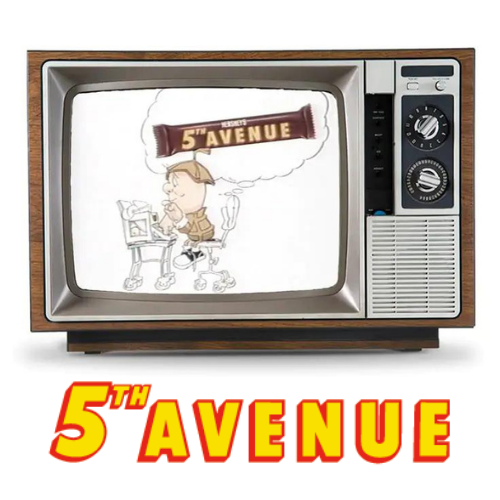
The Big Switch – Sans Almonds
Initially, the 5th Avenue candy bar was topped with roasted almond slices. This skinny, rectangular candy bar was even packaged in small cardboard boxes instead of in wrappers at the start of its era.
Luden’s company was the home of the 5th Avenue candy bar until 1986. Then, in 1986 the Hershey company purchased Luden, Inc. and took over the legacy of this candy bar.
After the buyout and 33 years of being notably topped with almonds, the Hershey company made a change. In 2019, the company decided to forego almonds, leaving just a milk chocolate coating with peanut butter crunchy layers inside.
This new version of the 5th Avenue candy bar remains simple without toasted almonds on top. Despite rejection from fans, this candy bar remains almond-less until this very day! Hopefully, they’ll add them back sometime soon, wishful thinking, we know!
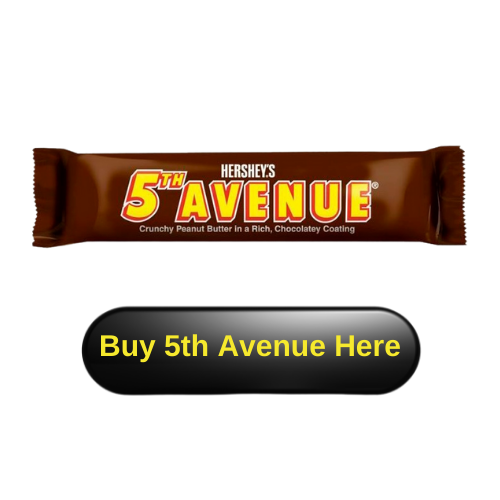
5th Avenue Candy Bar and the Media
While the 5th Avenue candy bar hasn’t printed ads since 1993, it still enjoys much media fame. Found in multiple television shows and movies, there are a few notable scenes worth mentioning.
In the 1994 film Stargate, Daniel Jackson (played by Michael Garrett Shanks) makes initial contact with the alien race by offering their leader a 5th Avenue candy bar. It’s speculated that sales of this treat skyrocketed after the film’s release.
The television show Seinfeld included 5th Avenue candy bars in not one, but two different episodes during its airing. One episode showcased the similarities between a 5th Avenue candy bar and its competition. In the end, the 5th Avenue candy bar reigned supreme!
Most notably was the 5th Avenue candy bar’s appearance at the Martinsville Speedway. Founder H. Clay Earles was a major fan of the candy bar; he insisted it was the only one sold to fans at the speedway. Sadly, he passed away in 1999, but we wonder what he would’ve thought about the almond-less 5th Avenue today!?
Recreating this Candy Bar at Home
On the bright side, there are a few ways to make this candy bar DIY style from the comfort of home. One recipe from a well-known blogger insists that this recipe will have you wondering if it’s actually homemade, or the real thing!
Ingredients:
4 ounces water
1 1/4 ounces molasses
1-ounce corn syrup
8 ounces sugar
1 vanilla bean, split and scraped
8 ounces roasted, salted peanuts
2 ounces powdered sugar
1/2 ounce corn flakes
40 ounces chocolate, divided
Prepare the candy:
Directions
Line a jelly roll pan (a 1/2 sheet pan) with a silicone mat and preheat the oven to 200° F.
In a medium pot, combine water, molasses, corn syrup, sugar, and vanilla bean seeds. Set over medium heat and stir gently with a fork, taking care not to splash, until sugar dissolves and the mixture begins to simmer.
Simmer, undisturbed, until the mixture reaches between 280 and 290°F on a candy thermometer. Due to the molasses, the mixture will have a sketchy burning smell, but remain within the recommended temperatures, and rest assured that it’s not actually burning. Cooking molasses just smells funky.
While the syrup is cooking, grind the peanuts and powdered sugar together in a food processor until the mixture forms a thick, damp mass with a texture like wet sand. Set aside.
When the syrup comes to temperature, immediately pour the mixture onto the silicone mat in the sheet pan, taking care to keep the syrup within the center of the mat. Wearing a pair of oven mitts, tilt the pan left and right to help the syrup evenly coat the silicon mat into a roughly 14” by 10” rectangular shape.
You can fold the candy back over on itself if any places flow out too far.
Layer the Candy
If you’ve ever laminated dough, this will be a familiar process; if not, imagine this next step as folding a business letter in thirds.
Sprinkle the ground peanut mixture in an even layer over 2/3 of the candy.
Use the silicone mat to fold the unsprinkled section up and over the center of the candy, just like the first fold of a business letter. If the candy sticks to the silicone, it’s still too hot. Wait a few moments for it to cool, then peel the silicone away; no rush. Now fold this double-thick section up and over the remaining piece. You will now have a 3 layer candy packet roughly 11” x 5”.
Place the sheet pan in the preheated oven for 5 minutes, or until the candy has become warm and pliable. Remove it from the oven and lift out the silicone mat, setting it on the counter. Use a rolling pin to gently roll it out to a 14” x 10” rectangle; it will take some elbow grease. If at any time the candy begins to make a cracking sound or feels too stiff to roll, return the pan to the oven for a minute or two. Take your time! Once you’ve rolled it out, fold it into thirds again just as you did the first time.
Return the candy to the oven for another 4 minutes, then roll back out to a 14” x 10” rectangle. Sprinkle this rectangle with corn flakes, as you did with the peanut mixture. Fold into thirds (if, while folding the candy makes a cracking noise, stop folding and return it to the oven for about a minute, then proceed with folding). Return the folded packet to the oven for another 4 minutes.
Cut the Candy Into Bars
Now roll the candy to 1/2” thickness and then transfer to a cutting board. Use a sharp knife to trim the edges, leaving a tidy rectangle behind. You may be able to immediately cut the candy into 10 long, thin bars. But you may find you need to return it to the oven for a minute or two. This generally depends on the temperature of the kitchen.
Crumb Coat the Bars
Due to the extreme flakiness of the candy, it’s important to “crumb coat” the candy bars before dipping them in chocolate. Do this by tempering 12 ounces of chocolate. Drizzle or pipe a thin line of chocolate onto the bottom of each candy piece and then flip each over to form a foot on the bottom. Next, drizzle a little chocolate over each bar and use a small pastry brush to evenly coat the bar in a thin layer of chocolate.
Dipping the Bars
Once the chocolate has set, temper the remaining chocolate and dip each bar. Store the finished bars in an airtight container, indefinitely.
Where to Buy in Store
If you’re looking to satisfy your sweet tooth in a pinch and would rather not wait for your homemade bars to cool, rest assured! That’s right; you can find 5th Avenue candy bars in most major retail stores. Even better, you can find them online and have them delivered straight to your front door.
On that note, the best source for all your candy needs is Candy Retailer. There, you’ll find 5th Avenue candy bars, and much more! Luckily, for you, you’re already here! Therefore, all you have to do is Click Here and we’ll conveniently link you to our 5th Avenue product page, which is where all the magic happens!



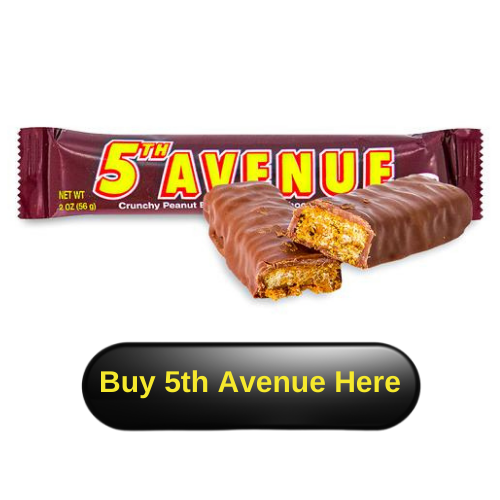
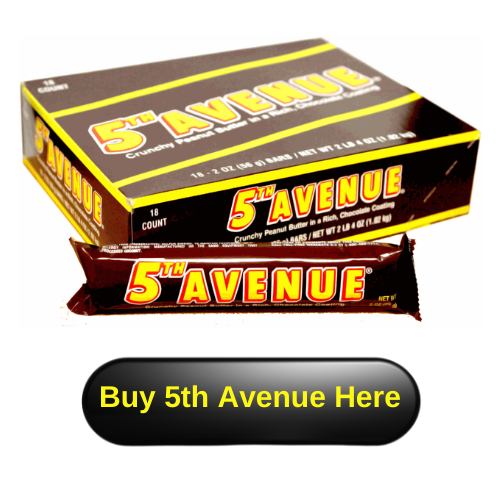
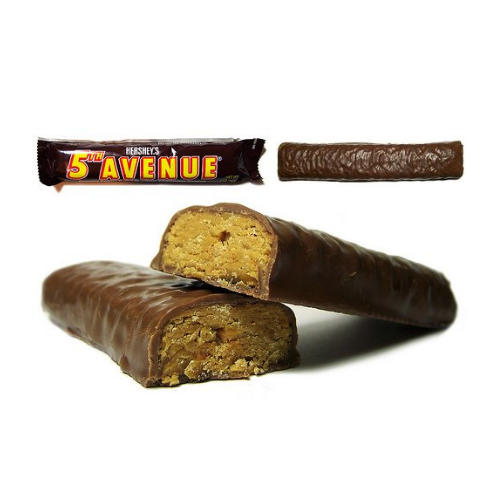
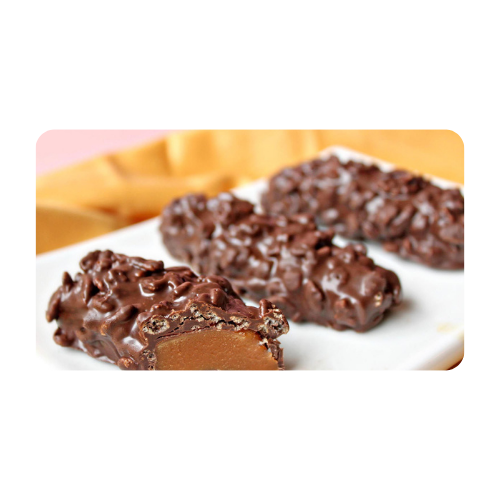
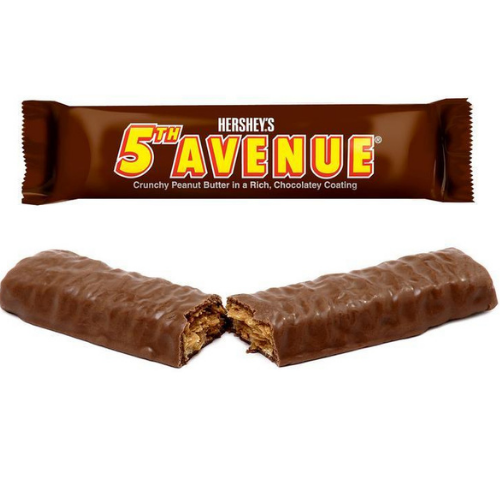

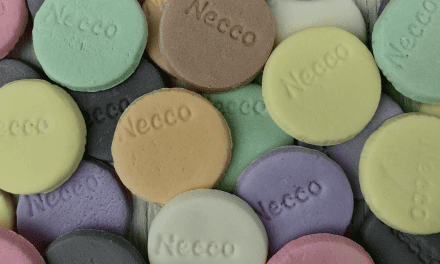



This bar is by far better that butter finger.